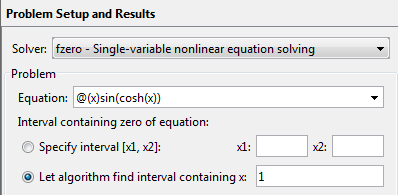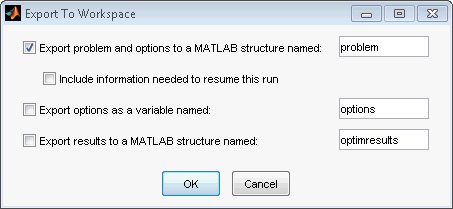fzero
Root of nonlinear function
Syntax
Description
Examples
Root Starting From One Point
Calculate
 by finding the zero of the sine function near
by finding the zero of the sine function near 3.
fun = @sin; % function x0 = 3; % initial point x = fzero(fun,x0)
x =
3.1416
Root Starting From an Interval
Find the zero of cosine between 1 and 2.
fun = @cos; % function x0 = [1 2]; % initial interval x = fzero(fun,x0)
x =
1.5708
Note that cos(1) and cos(2) differ in sign.
Root of a Function Defined by a File
Find a zero of the function f(x) = x3 – 2x – 5.
First, write a file called f.m.
function y = f(x)
y = x.^3-2*x-5;Save f.m on your MATLAB® path.
Find the zero of f(x)
near 2.
fun = @f; % function x0 = 2; % initial point z = fzero(fun,x0)
z =
2.0946Since f(x) is a polynomial, you can
find the same real zero, and a complex conjugate pair of zeros, using
the roots command.
roots([1 0 -2 -5])
ans = 2.0946 -1.0473 + 1.1359i -1.0473 - 1.1359i
Root of Function with Extra Parameter
Find the root of a function that has an extra parameter.
myfun = @(x,c) cos(c*x); % parameterized function c = 2; % parameter fun = @(x) myfun(x,c); % function of x alone x = fzero(fun,0.1)
x =
0.7854
Nondefault Options
Plot the solution process by setting some plot functions.
Define the function and initial point.
fun = @(x)sin(cosh(x)); x0 = 1;
Examine the solution process by setting options that include plot functions.
options = optimset('PlotFcns',{@optimplotx,@optimplotfval});
Run fzero including options.
x = fzero(fun,x0,options)
x =
1.8115

Solve Exported Problem
Solve a problem that is defined by an export from Optimization app.
Define a problem in Optimization app. Enter optimtool('fzero'),
and fill in the problem as pictured.
Note: The Optimization app warns that it will be removed in a future release. |

Select File > Export to Workspace,
and export the problem as pictured to a variable named problem.

Enter the following at the command line.
x = fzero(problem)
x =
1.8115More Information from Solution
Find the point where exp(-exp(-x)) = x, and display information about the solution process.
fun = @(x) exp(-exp(-x)) - x; % function x0 = [0,1]; % initial interval options = optimset('Display','iter'); % show iterations [x,fval,exitflag,output] = fzero(fun,x0,options)
Func-count x f(x) Procedure
2 1 -0.307799 initial
3 0.544459 0.0153522 interpolation
4 0.566101 0.00070708 interpolation
5 0.567143 -1.40255e-08 interpolation
6 0.567143 1.50013e-12 interpolation
7 0.567143 0 interpolation
Zero found in the interval [0, 1]
x =
0.5671
fval =
0
exitflag =
1
output =
intervaliterations: 0
iterations: 5
funcCount: 7
algorithm: 'bisection, interpolation'
message: 'Zero found in the interval [0, 1]'
fval = 0 means fun(x) = 0, as desired.
Related Examples
Input Arguments
fun — Function to solvefunction handle
Function to solve, specified as a handle to a scalar-valued
function. fun accepts a scalar x and
returns a scalar fun(x).
fzero solves fun(x) = 0. To solve an equation fun(x) = c(x),
instead solve fun2(x) = fun(x) - c(x) = 0.
To include extra parameters in your function, see the example Root of Function with Extra Parameter and the section Passing Extra Parameters.
Example: @sin
Example: @myFunction
Example: @(x)(x-a)^5 - 3*x + a - 1
Data Types: function_handle
x0 — Initial valuescalar | 2-element vector
Initial value, specified as a real scalar or a 2-element real vector.
Scalar —
fzerobegins atx0and tries to locate a pointx1wherefun(x1)has the opposite sign offun(x0). Thenfzeroiteratively shrinks the interval wherefunchanges sign to reach a solution.2-element vector —
fzerochecks thatfun(x0(1))andfun(x0(2))have opposite signs, and errors if they do not. It then iteratively shrinks the interval wherefunchanges sign to reach a solution. An intervalx0must be finite; it cannot contain ±Inf.
Tip
Calling |
Example: 3
Example: [2,17]
Data Types: double
options — Options for solution processstructure, typically created using optimset
Options for solution process, specified as a structure. Create
or modify the options structure using optimset. fzero uses
these options structure fields.
| Level of display (see Iterative Display):
|
| Check whether objective function values are valid.
|
| Specify one or more user-defined
functions that an optimization function calls at each iteration, either
as a function handle or as a cell array of function handles. The default
is none ( |
| Plot various measures of progress
while the algorithm executes. Select from predefined plots or write
your own. Pass a function handle or a cell array of function handles.
The default is none (
For information on writing a custom plot function, see Plot Functions. |
| Termination tolerance on |
Example: options = optimset('FunValCheck','on')
Data Types: struct
problem — Root-finding problemstructure
Root-finding problem, specified as a structure with all of the following fields.
| Objective function |
| Initial point for x,
scalar or 2-D vector |
| 'fzero' |
| Options structure, typically created
using optimset |
You can generate problem by exporting from
Optimization app. See Importing and Exporting Your Work or Solve Exported Problem.
Data Types: struct
Output Arguments
x — Location of root or sign changereal scalar
Location of root or sign change, returned as a scalar.
fval — Function value at xreal scalar
Function value at x, returned as a scalar.
exitflag — Integer encoding the exit conditioninteger
Integer encoding the exit condition, meaning the reason fzero stopped
its iterations.
| Function converged to a solution |
| Algorithm was terminated by the output function or plot function. |
|
|
-4 | Complex function value was encountered while searching for an interval containing a sign change. |
-5 | Algorithm might have converged to a singular point. |
-6 |
|
output — Information about root-finding processstructure
Information about root-finding process, returned as a structure. The fields of the structure are:
intervaliterations | Number of iterations taken to find an interval containing a root |
iterations | Number of zero-finding iterations |
funcCount | Number of function evaluations |
algorithm |
|
message | Exit message |
More About
References
[1] Brent, R., Algorithms for Minimization Without Derivatives, Prentice-Hall, 1973.
[2] Forsythe, G. E., M. A. Malcolm, and C. B. Moler, Computer Methods for Mathematical Computations, Prentice-Hall, 1976.